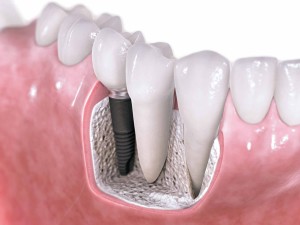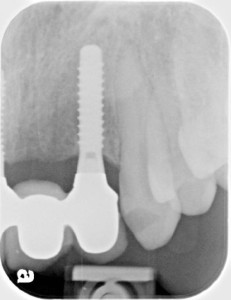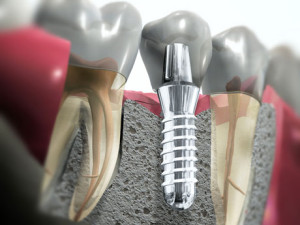What are Implants?
The loss of, or severely damaged teeth can occur at any age, and may effect a persons health, confidence, lifestyle, diet, and self-esteem. Dental implants fortunately can offer an effective, safe, and long-term solution to this problem for many people. Dental implants are essentially artificial teeth and are typically made of titanium and inserted into the jaw bones that are then used to fix a crown or bridge on top of the implant that then functions as a tooth. Implants are excellent options for people whom have lost a tooth or teeth due to decay, fractures, trauma, periodontal disease, or for some other reason.
They can be used to replace a single tooth, multiple teeth, or used to provide excellent stability and retention of dentures. Furthermore, implants can be used to replace teeth on the same day as they are removed (immediate implant), or inserted several months or even years after a tooth has been lost (delayed implant). Once the implant is surgically placed, over a period of weeks and months, the implant becomes intimately connected (or integrated) into the bone and gum tissues in the mouth.
Ideal Implant Patients
Dental implants like any other surgically placed prosthesis in the body has certain conditions that are more favourable to others for its long-term stability. Ideally, for a dental implant to be placed the patient should be in good general and oral health, have adequate bone in the jaw to support the implant where it needs to be placed, and have healthy gum tissues that are free of periodontal disease. In addition, just like natural teeth, regular long-term maintenance of the implant and good oral hygiene such as brushing and flossing is required along with visiting your general dentist for regular checkups are very important.
 The Implant Procedure
The Implant Procedure
Placing implants is a relatively straight forward procedure that can be performed by a skilled practitioner that has sound knowledge and further training in oral surgery, bone and soft tissue regenerative techniques, and an excellent knowledge of pharmacology and general medical conditions.
The procedure for placing an implant at our practice is a team effort between the patient, the general dentist and Dr Eldridge. Typically we receive referrals from dentists and other health professionals to perform the surgical phase of implant placement. Dr Eldridge and your dentist will consult with you to determine where and how your implant should be placed and a treatment plan is then constructed to meet your specific needs.
Dental implants represent the highest level of tooth replacement currently possible and should be as affordable as possible, for as many people as possible.
- Single Tooth implants are ideal for when only one tooth needs to be extracted or replaced.

- Multiple Teeth implants are used when more than one tooth needs to be replaced and can be completed by using an implant supported bridge.
- Implant supported dentures are ideal when an upper or lower jaw (or both) are missing all of the natural teeth and the existing dentures are unstable, uncomfortable, or there is an inability to chew properly.
- Sinus lifts may be required when there is not enough bone height in the posterior section of the upper jaw. This area of the jaw is one of the more difficult areas to place implants, especially when teeth have been missing for many years. A sinus lift can help correct this problem by ‘lifting’ the floor of the sinus and placing bone inside it to help with placement of an implant.
- Ridge modifications are occasionally required when there is inadequate bone in the upper or lower jaw where the implant needs to be placed. The area is filled with bone or a bone substitute that can greatly improve the long-term stability and aesthetics of the finished implant and crown.
We are regularly referred patients and have people contact our rooms requesting information on implants, and here at the Hobart Orofacial Pain and Special Needs Clinic, it is our aim and belief that the cost of dental implants should be as affordable as possible, for as many people as possible. Each case needs to be assessed as we are all unique individuals, and then a treatment plan is developed along with all associated costs for placing the implant as well as bone grafting, and sinus lifts if required.
 Our practice is able to place all of the major systems of dental implants including Ankylos, Straumann, Neoss, and BioHorizons depending on the general dentists requests, preference, and requirements. If you have been provided with a quote for placing implants, please compare our costs under the ‘Pricing Structure’ page.
Our practice is able to place all of the major systems of dental implants including Ankylos, Straumann, Neoss, and BioHorizons depending on the general dentists requests, preference, and requirements. If you have been provided with a quote for placing implants, please compare our costs under the ‘Pricing Structure’ page.
Dental Terms Explained
Abutment – Titanium alloy, zirconium oxide of other metals form a post which connects the implant with the final crown, fixed bridge or denture.
Biocompatible – Not having toxic or injurious effects on the human body or biological function.
Bone Resorption – The loss of bone volume and size.
Dental Implant – An artificial tooth that is surgically submerged into the jawbone.
Fixed Full Arch Restoration – A fixed complete upper or lower arch of teeth which cannot be removed.
Osseointegration – The bonding of bone to the dental implant surface.
Restoration – The artificial tooth or teeth which are created by a dental laboratory, and screwed or cemented onto the implant abutment.

